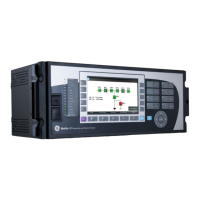GE Multilin D60 Line Distance Protection System 5-333
5 SETTINGS 5.7 CONTROL ELEMENTS
5
The TRANS BLOCK PICKUP DELAY should not be longer than the fastest possible trip time for faults on an adjacent line
so that extended blocking action could be established. This should take into account the pickup time of the reverse-
looking elements of the scheme.
The delay defined by this setting should not be too short in order to avoid locking up a spurious reverse fault indication
that can occur during internal fault conditions.
• TRANS BLOCK RESET DELAY: This setting defines a transient blocking mechanism embedded in the hybrid POTT
scheme for coping with the exposure of the overreaching protection functions to current reversal conditions (see also
the
TRANS BLOCK PICKUP DELAY).
This delay should be selected long enough to cope with transient conditions including not only current reversals but
also spurious negative and zero-sequence currents occurring during breaker operations (in the case when neutral
directional overcurrent or negative-sequence directional overcurrent functions are used). The breaker failure time of
the surrounding protection systems within the reach of the ground directional function used by the hybrid POTT
scheme should be considered to make sure that the ground directional function is not jeopardized during delayed
breaker operations.
• ECHO DURATION: This setting defines the guaranteed and exact duration of the echo pulse. The duration is not
dependent on the duration and shape of received RX signals. This setting enables the relay to avoid a permanent lock-
up of the transmit/receive loop.
• ECHO LOCKOUT: This setting defines the lockout period for the echo logic after sending the echo pulse. This enables
the relay to avoid oscillations of the echo pulses during an autoreclosure dead-time after clearing an internal fault.
• HYB POTT SEAL-IN DELAY: The output FlexLogic operand (
HYB POTT OP) is produced according to the hybrid POTT
scheme logic. The
HYB POTT SEAL-IN DELAY defines a minimum guaranteed duration of the HYB POTT OP pulse. As this
operand runs the trip table of the hybrid POTT scheme, the trip operands HYB POTT TRIP A, B, C and 3P are sealed-in
for the same period of time.
• GND DIR O/C FWD: This setting defines the FlexLogic operand (if any) of a protection element that is used in addition
to zone 2 for identifying faults on the protected line, and thus, for keying the communication channel and initiating oper-
ation of the scheme (both through the transient blocking logic). Good directional integrity is the key requirement for an
over-reaching forward-looking protection element used as
GND DIR O/C FWD.
Even though any FlexLogic operand could be used as GND DIR O/C FWD enabling the user to combine responses of var-
ious protection elements or to apply extra conditions through FlexLogic equations, this extra signal is primarily meant
to be the output operand from either the negative-sequence directional or neutral directional overcurrent elements.
Both these elements have separate forward (
FWD) and reverse (REV) output operands. The forward indication should
be used (NEG SEQ DIR OC1 FWD or NEUTRAL DIR OC1 FWD).
The selected protection element (or elements in combination) should be coordinated with the selection of GND DIR O/C
REV. For all the forward external faults seen by an element used as GND DIR O/C FWD at one end of the line, the reverse-
looking element used as
GND DIR O/C REV at the other end should pickup and provide a blocking signal. For greater
security and to overcome spurious directional element operation during transients, adding at least 0.5 cycles of pickup
delay to the forward directional element is recommended.
• GND DIR O/C REV: This setting defines the FlexLogic operand (if any) of a protection element used in addition to zone
4 for identifying reverse faults, and thus, for stopping the transmit signal and initiating the transient blocking timer.
Good directional integrity is the key requirement for a reverse-looking protection element used as
GND DIR O/C REV.
Even though any FlexLogic operand could be used as
GND DIR O/C REV enabling the user to combine responses of var-
ious protection elements or to apply extra conditions through FlexLogic equations, this extra signal is primarily meant
to be the output operand from either the negative sequence directional or neutral directional overcurrent element. Both
these elements have separate forward (
FWD) and reverse (REV) output operands. The reverse indication should be
used (
NEG SEQ DIR OC1 REV or NEUTRAL DIR OC1 REV).
The selected protection element (or elements in combination) should be coordinated with the selection of
GND DIR O/C
FWD
. For all the forward external faults seen by an element used as GND DIR O/C FWD at one end of the line, the
reverse-looking element used as
GND DIR O/C REV at the other end should pickup and provide a blocking signal. For
greater security and to overcome spurious directional element operation during transients, adding a pickup delay
greater than the pilot channel delay to the reverse directional element is recommended.
• HYB POTT NO OF COMM BITS: This setting specifies the number of bits of the communications channel available for
the scheme. The transmit codes and trip table of the hybrid POTT scheme are the same as those for the permissive
under-reaching transfer trip scheme. Please refer to the description of the PUTT scheme for more information.

